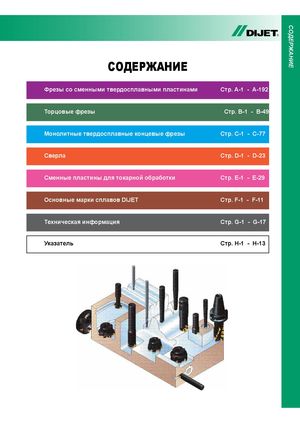Общий каталог Dijet 2018 - страница 4
Навигация

About Safety When Using Cutting Tool Products 1. When Using cutting tool products In accordance with the Product Liability Law (PL law) enforced on July 1st 1995, our company has attached warning labels and caution labels to the packaging of our applicable products. However, there are no specific caution notes displayed on the tools themselves. Before handling or using any cutting tool or cutting tool material, please read the sections “About safety when using cutting tool products” in this catalogue. In addition, please teach the information stated in these sections to all workers as part of the safety education at your company. Warning You can be killed or seriously injured if you don’t follow instructions. Caution You can be exposed to potential hazardous situation which, if not avoided,may result in minor or moderate injury. PROHIBITION - “Do Not” COMPULSION - “Do By All Means” 2. Basic Characteristics of Cutting Material. 2-1. Meanings of words used in this catalogue 2-1-1. Cutting tool materials: General terms such as carbide alloy, cermet, ceramics, sintered CBN, sintered diamond, cermetal etc 2-2. Physical Characteristics 2-2-1. Appearance: Varies depending on material properties and material type. Example: Gray, black, gold, etc. 2-2-2. Odor: Odorless 2-2-3. Hardness, Specific Gravity Material Hardness(HV) Gravity Carbide alloy 500~3000 9~16 Cermet 500~3000 5~9 Ceramic 1000~4000 2~7 Sintered CBN 2000~5000 3~5 Sintered Diamond 8000~12000 3~5 New composite material notincluding W & Co (Cermetal)500~3000 5~9 HSS 200~1200 7~9 Alloy steel 200~1200 7~9 2-2-4. Composition: Including carbides, nitrides and sulfides of W, Ti, Al, Si, Ta, Nb, B, V, etc. as well as metal compo- nents of Fe, Co, Ni, Cr, Mo, etc. 2
 Общий каталог Dijet 2012 на русском
Общий каталог Dijet 2012 на русском